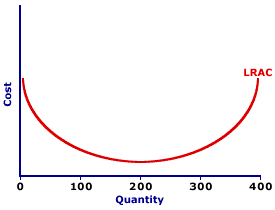
|
|
TP: The abbreviation for total product, which is the total quantity of output produced by a firm for a given quantity of inputs. Total product is the foundation upon which the analysis of short-run production for a firm is analyzed. The usual framework is to analyze total product when in a variable input (labor) changes, for a given amount of a fixed input (capital). Two related concepts derived from total product are average product and marginal product.
Visit the GLOSS*arama
|
|


|

|
                           PLANNING HORIZON: Another term for the long-run average cost curve. The long-run average cost curve is termed the planning horizon or planning curve because it provides information that a firm can use to plan factory construction and expansion in the long run. A long-run average cost curve, or planning curve, is displayed in the exhibit below. This curve has the expected U-shape created by economies of scale (or increasing returns to scale) for small quantities of output and diseconomies of scale (or decreasing returns to scale) for large output quantities. Of note is that this long-run average cost curve is an envelope of several short-run average total cost curves.Short and Long, Together| Long Run Average Cost |  |
To see why the long-run average cost curve is termed a planning curve, a distinction between the short-run and long-run operation of firm is in order. Short-run operation requires that a firm decide the quantity of variable inputs it needs in order to produce a given output, given one or more fixed input. In other words, Waldo's TexMex Taco World must decide how many workers to employ and how much lettuce and sour cream to buy each day. But Waldo is not really concerned with the size of the restaurant for day-to-day operation. The restaurant is a given.When Waldo expects limited business on the weekdays, he purchases small quantities of lettuce and sour cream and schedules only a handful of employees. However, when he expects to sell more on the weekends, he schedules more employees and purchases more lettuce and sour cream. In effect, Waldo is using a given short-run average and marginal cost curves such as the ones labeled SRATC(a) and SRMC(a) that can be revealed by clicking the button labeled [Short Run]. As demand (and price) change in the short-run, Waldo adjusts his output quantity based on his marginal cost. However, even as Waldo makes these day-to-day decisions about short-run production, he has his eye on the long run. He has plans to buy additional capital equipment, add a few more tables and chairs, and expand the size of the restaurant. Even as Waldo schedules the number of employees to work next Thursday, he is also reviewing architectural plans for the new construction. Even as he orders extra boxes of lettuce for the weekend, he is making a decision between oak chairs or pine. In essence, a firm operates in both the short run and the long run simultaneous. Long Run AdjustmentWaldo's long run plans are intertwined with his day-to-day operation. If a firm determines that day-to-day operations are straining the capacity of the fixed input, then it is likely to move ahead on plans to expand. Waldo, for example, realizes that his restaurant cannot service all of his potential customers. Every day, a line of customers extends out the door and circles the block. This is just the sort of thing that induces Waldo to expand his restaurant, to move from short run to the long run. In effect, Waldo is deciding if he should shift his current short-run cost curves from SRATC(a) and SRMC(a), to another set. Clicking the [Long Run Expansion] button reveals such a new set of curves, SRATC(b) and SRMC(b), associated with reducing the size of his restaurant.However, if Waldo's restaurant is never more than half filled with day-to-day operations, then he might decide to remodel his existing place or move to a smaller one. Once again, Waldo intertwines the short run and the long run. In effect, Waldo is deciding if he should shift his current short-run cost curves from SRATC(a) and SRMC(a), to another set. Clicking the [Long Run Reduction] button reveals such a new set of curves, SRATC(c) and SRMC(c), associated with reducing the size of his restaurant.

Recommended Citation:PLANNING HORIZON, AmosWEB Encyclonomic WEB*pedia, http://www.AmosWEB.com, AmosWEB LLC, 2000-2025. [Accessed: July 5, 2025].
Check Out These Related Terms... | | | | | | |
Or For A Little Background... | | | | | | | | | | |
And For Further Study... | | | | | | |
Search Again?
Back to the WEB*pedia
|



|

|
|
Much of the $15 million used by the United States to finance the Louisiana Purchase from France was borrowed from European banks.
|

|
|
"Plans are only good intentions unless they immediately degenerate into hard work." -- Peter Drucker, management consultant
|

|
ACRS
Accelerated Cost Recovery System
|

|
|
Tell us what you think about AmosWEB. Like what you see? Have suggestions for improvements? Let us know. Click the User Feedback link.
User Feedback
|


|


